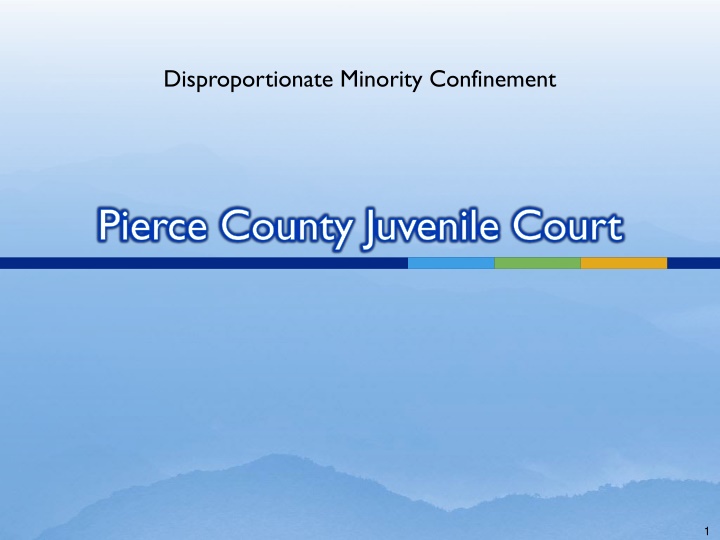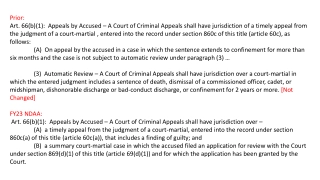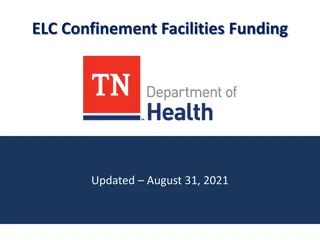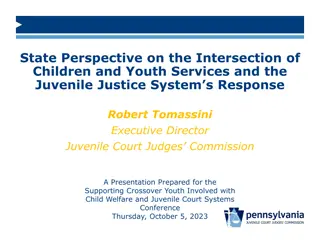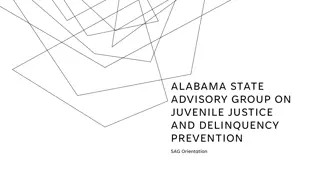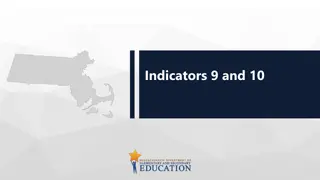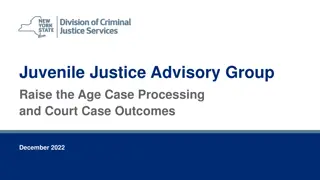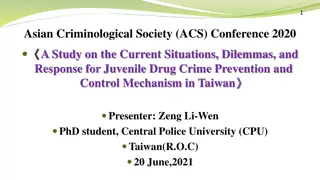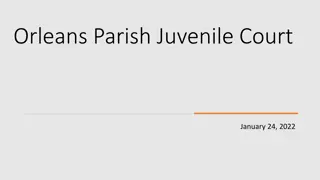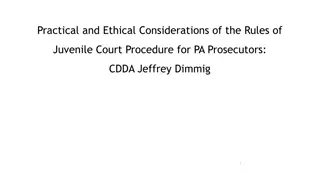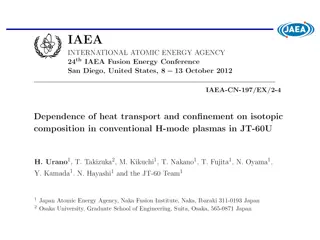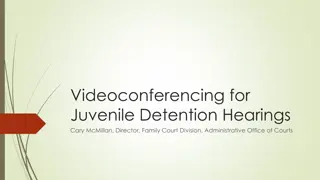Disproportionate Minority Confinement in Pierce County Juvenile Court
In Pierce County Juvenile Court, efforts are being made to reduce Disproportionate Minority Confinement (DMC). This involves judicial leadership, strong partnerships, and addressing racial disparities in the juvenile justice system. The agenda includes reviewing progress, challenges faced, and key messages for promoting equity. Data on youth population and detention rates highlight the disparities that need to be addressed through collaborative and focused efforts.
Download Presentation

Please find below an Image/Link to download the presentation.
The content on the website is provided AS IS for your information and personal use only. It may not be sold, licensed, or shared on other websites without obtaining consent from the author.If you encounter any issues during the download, it is possible that the publisher has removed the file from their server.
You are allowed to download the files provided on this website for personal or commercial use, subject to the condition that they are used lawfully. All files are the property of their respective owners.
The content on the website is provided AS IS for your information and personal use only. It may not be sold, licensed, or shared on other websites without obtaining consent from the author.
E N D
Presentation Transcript
Disproportionate Minority Confinement Pierce County Juvenile Court 1
Todays Agenda Provide information on how Pierce County established a DMC reduction agenda Review lessons learned Report out on areas of progress and areas still needing improvement 2
Leadership and Support Judicial Leadership High Quality Technical Assistance and Training -Annie E. Casey Foundation -State AECF Team Leader -Burns Institute Funding from AECF, WA-PCJJ (formerly GJJAC) 3
Challenges Strengths Strong Judicial leadership Navigating difficult conversations about Racial and Ethnic Disparities (RED) Progressive culture Engaged and active case processing group Effectively engaging communities of color and community based organizations Active community with a history of partnering Results; Success breeds success Fiscal pressures that aren t in alignment with JDAI Principles 4
Key Messages Judicial Leadership prioritizing and promoting the examination of racial disparities Collaboration and partnerships important community, prosecutor, defense, schools, etc. Court must be committed and stay focused, this work is complex Learn, manage, improve" model Stick to the principles of JDAI 5
Pierce County Youth Population, age 10 - 17 7% 10% 2% Caucasian African American Native American Hispanic Asian/Pac. Islander 11% 70% 7
Average Daily Population 2000-2011 180 ADP Overall ADP African American ADP Caucasian Linear (ADP Overall) 163 161 160 150 147 140 120 108 100 82 80 74 74 65 60 47 44 36 40 20 0 2000 2001 2002 2003 2004 2005 2006 2007 2008 2009 2010 2011 8
Race in Detention 2000-2011 58% 60% 56% 56% 54% 53% 52% 50% 47% 47% 47% 46% 45% 41% 40% 36% 36% 33% 34% 33% 32% 30% 30% 29% 30% 27% 27% 25% 20% 12% 11% 9% 9% 9% 8% 8% 8% 8% 10% 6% 7% 7% 7% 7% 7% 6% 6% 7% 7% 5% 6% 5% 5% 4% 5% 5% 5% 5% 5% 3% 4% 5% 4% 4% 3% 4% 0% 2000 2001 2002 2003 2004 2005 2006 2007 2008 2009 2010 2011 Caucasian African American Hispanic Asian/P.I. Native American 9
Average Length of Stay in Detention African American Caucasian 16 2004 2006 2008 2010 14 12 Caucasian 11 8 8 7 10 African American 14 10 10 10 8 6 Hispanic 16 10 9 11 4 2 Asian/P.I. 10 15 10 13 0 Native American 2004 2006 2008 2010 12 12 11 7 10
What we know African American youth are: Referred at a rate that is 2.5 times higher than the rate of Caucasian youth Brought to detention at a rate that is 3.4 times higher than Caucasian youth Detained at a rate that is 3.6 times higher than Caucasian youth Detained for a high DRAI score (over 10) at a rate that is 5.9 times more than Caucasian youth Booked into detention for a B+ felony of higher at a rate that is 3.5 times higher than Caucasian youth Committed to JRA at a rate that is 5.2 times higher than Caucasian youth (2009 data) 11
JDAI in Pierce County Gather Data Enhance/Modify Program to Improve Outcomes Analyze with Staff (DMC lens) Implement and Monitor - Gather Data Practice/Policy Recommendations 13
Detention Risk Assessments, 2009 Release with Conditions (PRR) 332 Detain 2136 Release 412 Court Detained 262 Low=241, Mod=7, High=14 High RAI Score 479 Low & Moderate RAI 1395 PolicyHolds (Special Detention) 736 Policy Holds (Overrides) 659 Cannot locate parents 298 Federal Law 0 State Law 0 Local Policy 736 Parents refused youth 301 PCJCWarrant 300 Other 60 Probation Violation 190 Other 143 DV 143 14
Setting goals We predicted if we could impact Probation Violations, Warrants, Domestic Violence, and Parent Refusals, then we could impact detention admissions and bednights At the same time, build on Evidence Based Programs to reduce recidivism 15
Strategies to Reduce Detention Admissions and Bednights for African American Youth Reduce Failure to Appear Warrants Increase Number Served in Alternatives to Detention Reduce Probation Violations Goal: Reduce Detention Admissions and Bednights for AA youth Increase Number Served in ART Reduce Parent Refusals Increased Number Served in FFT 16
DMC Reduction Strategies and Action Steps Baseline Data (2007) Current Data (2010) Goal Admissions 130 % Admission 28.8% Bednights % Bednights 20.0% ALOS Admissions 80 % Admission 25% Bednights % Bednights 31% ALOS Increase attendance at court hearings to reduce detention admissions & LOS 1. Reduce AA Youth Failure to Appears (FTA) Phone & In-Person Notification (Enhanced Oct. 08) Two-Tier Warrant Process Bench Warrant Quash Program (Started Oct. 09) 903 563 6.9 days 5.8 days Admissions 37 % Admission 28% Bednights % Bednights 20% ALOS Admissions 95 % Admission 33.5% Bednights % Bednights 29.1% ALOS 2. Reduce AA Youth Violation Detention Episodes Standardize sanctions with supervisor staffings & implement a staffing guide Utilize ATDs in lieu of detention New procedures for failure to reside Reduce detention admissions & LOS for violations 149 918 5.9 days (39% drop) 9.7 days Reduce the number of youth detained due to parents refusing to accept custody who are eligible for release Admissions 67 % Admission 32% Bednights % Bednights 27% Admissions 86 % Admission 28% Bednights % Bednights 33% 3. Reduce AA Parent Refusal Detention Overrides Survey why parents refuse to accept custody Teach Detention staff effective methods to engage parents Develop alternatives in the community 163 363 AA Youth Served 41 # Completed 27 % Completed 66% # In/Out % In/Out AA Youth Served 50 # Completed 33 % Completed # In/Out % In/Out Increase the number of AA youth served and successfully complete FFT 4. Increase the Number of AA Youth to Successfully Complete FFT Specialized FFT caseload for AA youth Enhance culturally competent instruction 66% 16 24% 13 24% 5. Increase the Number of AA Youth to Successfully Complete ART Reduce the barriers to participation (i.e. provide transportation, increase motivation of youth) Increase the referral and retention rate Increase the number of AA youth served and successfully complete ART AA Youth Served 36 # Completed 23 % Completed 64% AA Youth Served 71 # Completed % Completed 57 80% Of total youth served in ADS, % AA AA Youth Served 402 # Completed 281 % Completed 70% Of total youth served in ADS, % AA AA Youth Served 215 # Completed % Completed Increase the number of AA youth served and successfully complete ADS 34% 31% 6. Increase Usage of Alternatives to Detention for AA Youth CDET, EHM, Weekend AD 160 74% 17
Strategy 1 Reduce FTAs DMC Reduction Strategies and Action Steps Reduce AA Youth Failure to Appears (FTA) Baseline Data (2007) Current Data (2010) Goal Reduce detention admissions & LOS for violations Admissions 130 Admissions 80 % Admissions 28% % Admissions 25% Phone & In-Person Notification (Enhanced Oct. 08) Bednights 903 Bednights 563 Two-Tier Warrant Process % Bednights 20% % Bednights 31% Bench Warrant Quash Program (Started Oct. 09) ALOS 6.9 days ALOS 5.8 days 18
Strategy 2 Reduce Violations DMC Reduction Strategies and Action Steps Reduce AA Youth Violation Detention Episodes Baseline Data (2007) Current Data (2010) Goal Reduce detention admissions and LOS for violations Admissions 95 Admissions 37 % Admissions 34% % Admissions - 28% Standardize sanctions with supervisor staffings & implement a staffing guide Bednights 918 Bednights 149 Utilize ATDs in lieu of detention % Bednights 29% % Bednights 20% New procedures for failure to reside ALOS 9.7 days ALOS 5.9 days 19
African American Youth DMC Reduction Detained Youth 2007 2010 Reduction # % # % Detention Admits 887 31 572 30 36% decrease 235 less admits Bednights 9094 35 4579 35 50% decrease 3451 less bednights 20
Two Common Ways to Report Disproportionality Rates of Disproportionality -- Tells us the extent of over- or under- representation of a population Risk Ratio -- Tells us the relative disproportionality of one group compared to another group 21
Disproportionality Rate Calculation State A % FC Pop Rate % Child Pop White 74% 64% 64/74= .86 32/18= 1.8 Afr-Am 18% 32% A number less than 1 represents UNDER-representation; larger than 1=OVER-representation 22
Risk Ratio Calculation State A % Child Rate % FC Pop Risk Ratio Pop White 74% 64% 64/74=. 86 32/17= 1.9 Afr-Am 18% 32% 1.9/.86 =2.2 In this example, African American children are in foster care at a rate that is 2.2 times higher than the rate for White children 23
Example Overall Youth Detained African American Detained % African American Detained Risk Ratio Year 2006 3104 958 31% 3.9 2009 2136 652 31% 3.6 24
Risk Ratio Warrants and PVs Warrant PV 6 5.4 5 4.2 4.2 4.1 4 3.5 3.5 3.2 3 2.7 2 1 0 2006 2007 2008 2009 25
Summary Reducing racial disparities is very complex Must focus on the principles of JDAI - leadership, collaboration, focused and intentional strategies, data driven decision making To sustain the effort, must create a paradigm shift It s all about creating a fair and equitable system for the kids in our community 26
Contact Information TJ Bohl Assistant Administrator Probation Pierce County Juvenile Court tbohl@co.pierce.wa.us Kevin Williams JDAI Coordinator/Probation Supervisor Pierce County Juvenile Court kwillia@co.pierce.wa.us 27
